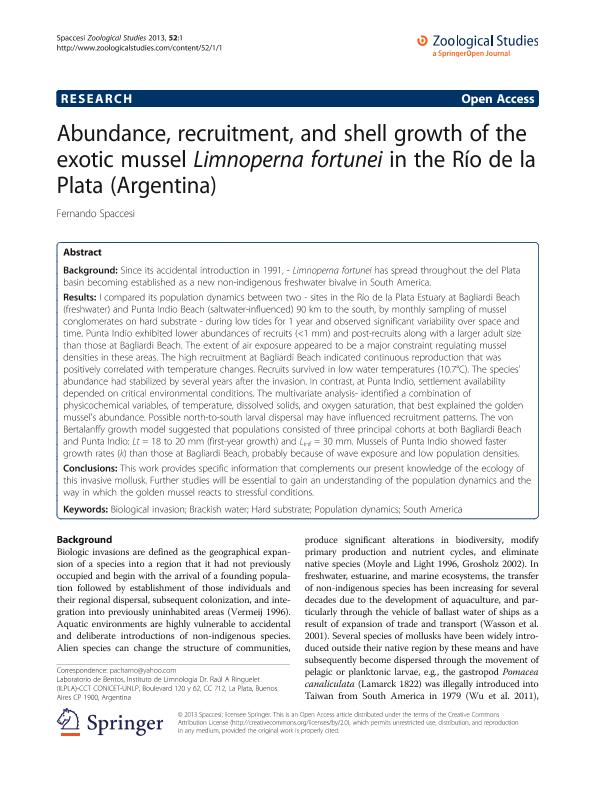Artículo
Abundance, Recruitment, and Shell Growth of the Exotic Mussel Limnoperna fortunei in the Río de la Plata, Argentina
Fecha de publicación:
08/2013
Editorial:
Acad Sinica Inst Zoology
Revista:
Zoological Studies
ISSN:
1021-5506
Idioma:
Inglés
Tipo de recurso:
Artículo publicado
Clasificación temática:
Resumen
Since its accidental introduction in 1991, Limnoperna fortunei has spread throughout the del Plata basin becoming established as a new non-indigenous freshwater bivalve in South America.I compared its population dynamics between two - sites in the Río de la Plata Estuary at Bagliardi Beach (freshwater) and Punta Indio Beach (saltwater-influenced) 90 km to the south, by monthly sampling of mussel conglomerates on hard substrate - during low tides for 1 year and observed significant variability over space and time. Punta Indio exhibited lower abundances of recruits (<1 mm) and post-recruits along with a larger adult size than those at Bagliardi Beach. The extent of air exposure appeared to be a major constraint regulating mussel densities in these areas. The high recruitment at Bagliardi Beach indicated continuous reproduction that was positively correlated with temperature changes. Recruits survived in low water temperatures (10.7°C). The species´ abundance had stabilized by several years after the invasion. In contrast, at Punta Indio, settlement availability depended on critical environmental conditions. The multivariate analysis- identified a combination of physicochemical variables, of temperature, dissolved solids, and oxygen saturation, that best explained the golden mussel´s abundance. Possible north-to-south larval dispersal may have influenced recruitment patterns. The von Bertalanffy growth model suggested that populations consisted of three principal cohorts at both Bagliardi Beach and Punta Indio: Lt = 18 to 20 mm (first-year growth) and Linf = 30 mm. Mussels of Punta Indio showed faster growth rates (k) than those at Bagliardi Beach, probably because of wave exposure and low population densities.This work provides specific information that complements our present knowledge of the ecology of this invasive mollusk. Further studies will be essential to gain an understanding of the population dynamics and the way in which the golden mussel reacts to stressful conditions.
Archivos asociados
Licencia
Identificadores
Colecciones
Articulos(ILPLA)
Articulos de INST.DE LIMNOLOGIA "DR. RAUL A. RINGUELET"
Articulos de INST.DE LIMNOLOGIA "DR. RAUL A. RINGUELET"
Citación
Spaccesi, Fernando Gustavo; Abundance, Recruitment, and Shell Growth of the Exotic Mussel Limnoperna fortunei in the Río de la Plata, Argentina; Acad Sinica Inst Zoology; Zoological Studies; 52; 1; 8-2013; 1-11
Compartir
Altmétricas




